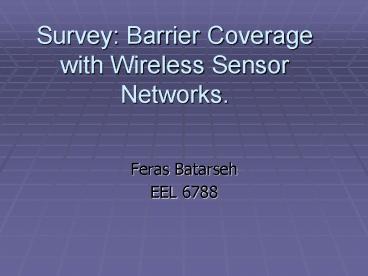Survey: Barrier Coverage with Wireless Sensor Networks. - PowerPoint PPT Presentation
Title:
Survey: Barrier Coverage with Wireless Sensor Networks.
Description:
Survey: Barrier Coverage with Wireless Sensor Networks. Feras Batarseh EEL 6788 Presentation s Outline Introduction Characteristics Algorithms/ Methodologies ... – PowerPoint PPT presentation
Number of Views:121
Avg rating:3.0/5.0
Title: Survey: Barrier Coverage with Wireless Sensor Networks.
1
Survey Barrier Coverage with Wireless Sensor
Networks.
- Feras Batarseh
- EEL 6788
2
Presentations Outline
- Introduction
- Characteristics
- Algorithms/ Methodologies
- Algorithms Comparison and Complexity
- Topologies
3
Introduction
- Wireless network consists of spatially
distributed autonomous devices using sensors to
monitor physical or environmental conditions. - The development of wireless sensor networks was
originally motivated by military applications
such as battlefield surveillance.
4
A look back..
- Moats?
- Walls?
- Landmines?
5
WSN Characteristics
- More effective.
- More efficient.
- Covers more areas.
- Ability to withstand harsh environmental
conditions. - Ability to cope with node failures.
- Mobility of nodes.
- Dynamic network topology.
6
Goals
- Stealthiness A sensor network is said to
- satisfy the stealthiness assumption if no
- intruder is aware of the locations of the
- sensors.
- k-coverage of a path A path (i.e. line
- or curve) is said to be k-covered if every
- point in it is covered by at least k sensors.
7
Breach?
Intersection point method (IPM) Association
Sensors Method (ASM) Probing
8
IPM
- Using polygons to cover an area.
- Sensors on polygon edges
- Overlappingbad
- Intersectingbad
- Tillinggood
- Insidemultiple protection
9
ASM
- FOR (each node)
- Check Radius of coverage area
- Check all intersection points of area
- if diameter is inside other coverage areas of
sensors - Sensor go to Sleep
- //end of loop
Optimization protocol to make sure that the
coverage of the entire network will not drop
early nor fast.
10
Probing
- Sleeping nodes wake up
- periodically and broadcast a
- probing signal to detect the
- active sensors in their probing
- range. If no active sensor is
- detected, the sensor switches to
- active state, otherwise the
- sensor resets its sleep timer
- and goes back to sleep.
11
Complexity
- IPM O (kmnm) log (nm))
- ASM O (nm2n)
- Probing O (n)
- Where
- n is average number of neighbors of a node
- m is number of nodes
- k average edges involved in the node
12
Comparison
- 1. IPM
- Complex
- slower algorithm
- efficient
- 2. Probing
- Fast
- Simple
- un necessary power wasted!
- 3. ACM
- Slow
- Assumes full power of sensor!
13
Barrier Sensors Topologies
- Disc-based sensing where each active sensor has
a sensing radius of r any object within the disc
of radius r centered at an active sensor is
reliably detected by it. - RIS scheme Time is divided in regular intervals
and in each interval, each - sensor is active.
- Belt of dimension w X h A rectangular region.
14
Barrier Sensors Topologies
Depends on the shape of the barrier/area to cover.
15
References
- 1- Barrier coverage with wireless sensors
- Santosh Kumar, Ten H. Lai, Anish Arora
- August 2005
- MobiCom '05 Proceedings of the 11th annual
international conference on Mobile computing and
networking - 2- Reliable density estimates for coverage and
connectivity in thin strips of finite length - Paul Balister, Béla Bollobas, Amites Sarkar,
Santosh Kumar - September 2007
- MobiCom '07 Proceedings of the 13th annual ACM
international conference on Mobile computing and
networking - 3- Coverage breach problems in bandwidth-constrain
ed sensor networks - Maggie X. Cheng, Lu Ruan, Weili Wu
- June 2000
- ACM Transactions on Sensor Networks (TOSN),
Volume 3 Issue 2 - 4- Coverage protocols for detecting fully
sponsored sensors in wireless sensor networks - Azzedine Boukerche, Xin Fei
- October 2006
- PE-WASUN '06 Proceedings of the 3rd ACM
international workshop on Performance evaluation
of wireless ad hoc, sensor and ubiquitous
networks - 5- Results on coverage for finite wireless
networks - Woei Ling Leow, Hossein Pishro-Nik
- August 2007
16
References 2
- 6- Designing localized algorithms for barrier
coverage - Ai Chen, Santosh Kumar, Ten H. Lai
- September 2007
- MobiCom '07 Proceedings of the 13th annual ACM
international conference on Mobile computing and
networking - 7- Multi-Agent Simulation For Assessing Massive
Sensor Deployment - CAPT Sean E. Hynes, USMC, and Neil C. Rowe
- July 2004
- Journal of Battlefield Technology, Vol. 7, No. 2,
July 2004, 23-26 - 8-Constraint Coverage for Mobile Sensor Networks
- S Poduri, GS Sukhatme
- April 2004
- Robotics and Automation. Proceedings. ICRA'04
- 9- Overload traffic management for sensor
networks - Chieh-Yih Wan, Shane B. Eisenman, Andrew T.
Campbell, Jon Crowcroft - October 2007
- ACM Transactions on Sensor Networks (TOSN),
Volume 3 Issue 4 - 10- The self-protection problem in wireless
sensor networks - Dan Wang, Qian Zhang, Jiangchuan Liu
17
Thank You
Questions?






























